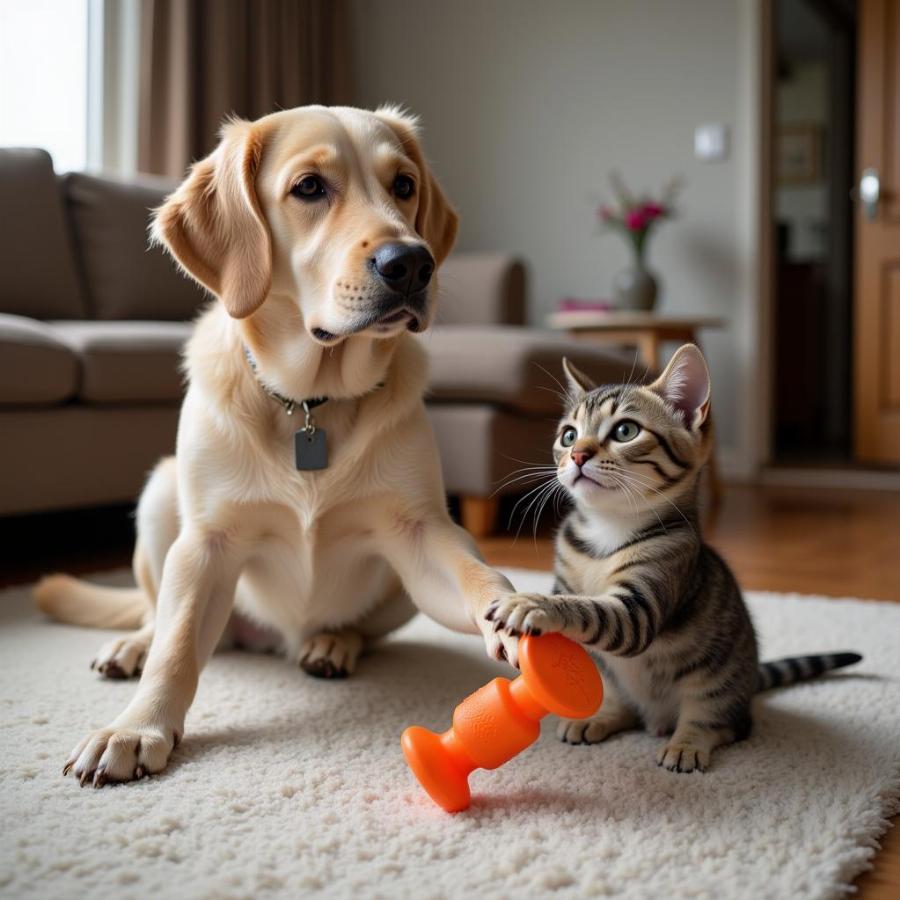Introducing a new dog to your resident cat can be a delicate process, but with patience and the right approach, it can lead to a peaceful and even loving coexistence. This guide will provide a step-by-step approach on how to introduce a new dog to a cat, minimizing stress for both pets and maximizing the chances of a harmonious relationship.
Preparing for the Introduction
Before bringing your new dog home, prepare your environment to minimize potential conflict. Create a safe space for your cat, equipped with food, water, litter box, scratching post, and comfortable bedding. This area should be off-limits to the dog, allowing your cat a sanctuary to retreat to when feeling overwhelmed. Ensure this safe haven is in a room the dog cannot access, perhaps using a baby gate or closing the door. This will allow your cat to observe the dog from a safe distance without direct interaction. Consider pheromone diffusers, like Feliway, to help calm your cat during this transition.
The Initial Introduction: Scent Swapping
Begin by introducing the pets’ scents to each other. Swap bedding or toys between the animals so they can become accustomed to each other’s smell before any face-to-face interaction. You can also rub a towel on your dog and place it under your cat’s food bowl, and vice versa. This helps them associate each other’s scent with something positive.
First Encounters: Controlled and Supervised
After a few days of scent swapping, allow brief, supervised visual contact. Keep the dog on a leash and allow the cat to observe from a safe distance. Reward calm behavior with treats and praise. If either animal shows signs of stress, like hissing, growling, or flattened ears, separate them immediately and try again later with shorter sessions. Gradually increase the duration of these encounters as both animals become more comfortable.
Gradual Integration: Shared Space and Supervised Interaction
Once both pets seem relaxed during visual contact, you can proceed to supervised interactions in the same room. Keep the dog leashed and allow the cat to move freely. If they show signs of aggression or fear, separate them immediately. Short, positive interactions are key.
Unsupervised Interactions: Slow and Steady
When both animals consistently exhibit calm and relaxed behavior during supervised interactions, you can begin allowing short periods of unsupervised time together. Start with very brief periods and gradually increase the duration as they become more comfortable with each other’s presence. Always ensure the cat has access to its safe space.
 Dog and Cat Playing Together Peacefully in a Living Room
Dog and Cat Playing Together Peacefully in a Living Room
Potential Challenges and Solutions
What if my cat hides and won’t come out? This is normal. Don’t force interaction. Let your cat adjust at its own pace. Ensure the cat has access to its safe space, and continue scent swapping.
What if my dog is too excited and chases the cat? Keep the dog on a leash and redirect its attention with toys or treats when it fixates on the cat. Reward calm behavior.
What if my cat hisses or swats at the dog? This is a warning sign. Separate the animals and try again later with shorter, more controlled interactions.
Conclusion
Introducing a new dog to a cat requires patience, understanding, and careful planning. By following these steps and being attentive to your pets’ individual needs, you can foster a peaceful and harmonious relationship between your furry companions. Remember to take things slowly and celebrate small victories. With time and effort, your dog and cat can learn to coexist and even become friends.
FAQ
- How long does it take for a cat and dog to get used to each other? This varies greatly, from a few weeks to several months.
- Can I leave my dog and cat alone unsupervised right away? No, it’s crucial to build trust gradually through supervised interactions.
- What if my dog has a high prey drive? Extra caution is necessary. Consult with a professional dog trainer for personalized guidance.
- Is it normal for my cat to be stressed during the introduction process? Yes, some stress is expected. Provide a safe space and be patient.
- What are the signs of a successful introduction? Relaxed body language, shared space, and even playful interactions.
Suggested Further Reading
Beaut Dogs is your trusted resource for all things related to dog ownership, offering expert advice and guidance on how to care for your canine companion. From breed selection to nutrition and training, we’re here to help you navigate the joys and challenges of dog ownership. For personalized support and answers to your specific questions, please contact us at Email: [email protected]. Beaut Dogs is committed to providing valuable and reliable information to help you create a happy and healthy life for your beloved dog.